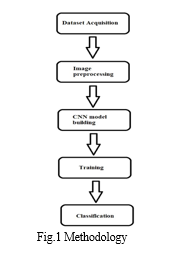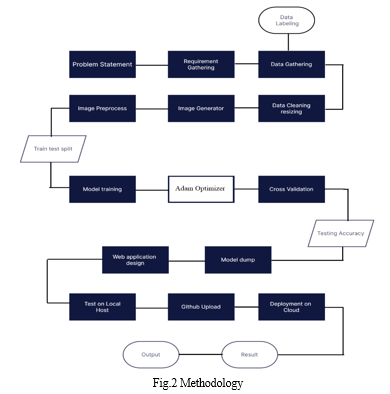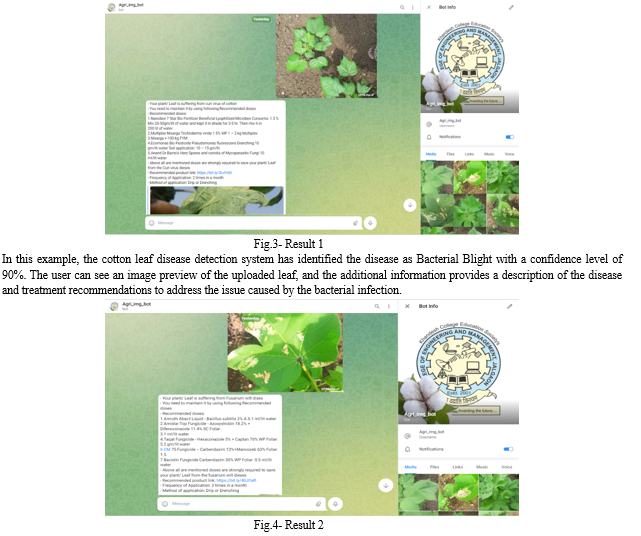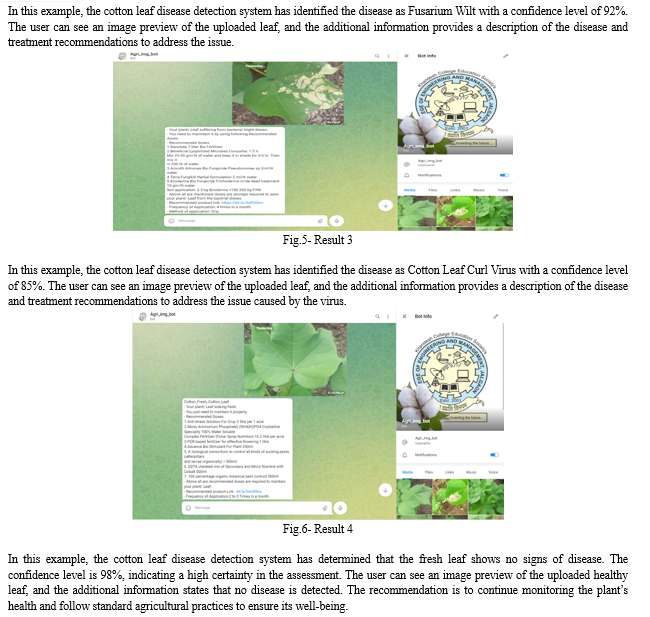Ijraset Journal For Research in Applied Science and Engineering Technology
- Home / Ijraset
- On This Page
- Abstract
- Introduction
- Conclusion
- References
- Copyright
Image Classification by Tensorflow
Authors: Kashif Shaikh, Dnyaneshwar Pawar, Gaurav Patil, Rahul Patil, Prof. Hemant Wani
DOI Link: https://doi.org/10.22214/ijraset.2023.53817
Certificate: View Certificate
Abstract
The task of relating what an image represents is called image bracket. An image bracket model is trained to fete colorful classes of images. For illustration, you may train a model to fete prints representing three different types of creatures rabbits, pussycats, and tykes . But in our design we\'ve used the datasets of cotton splint which helps us to find the complaint on the cotton splint as well. Tensorflow is an google open source machine literacy frame for dataflow programming across a range of task. As well as it\'s a open source library for deep literacy operation. It\'s firstly developed for large numerical calculation without keeping deep literacy in mind. In the design of image bracket, one model was erected to sort images. By using the model which was erected in the design, filmland can be classified effectively and snappily. At the morning of the design, an applicable data set was chosen. also, the model was created by using TensorFlow. Next, the model would be trained to get the parameters with good fitting. Eventually, in order to estimate the model effectively, several graphs of confirmation delicacy were created. In the process of completing this design, the members of Team have learned the capability to construct convolutional neural network models using python. What’s more, the members of the platoon also develop a good capability of data analysis.
Introduction
I. INTRODUCTION
The thing of this design is to develop a Telegram converse bot that can classify images of cotton leaves and determine whether they're healthy or diseased. The design uses a deep literacy model erected with TensorFlow and Keras to perform the image bracket. Cotton is an important cash crop in numerous countries, and its leaves are susceptible to colorful conditions that can oppressively impact yields. Beforehand discovery and treatment of these conditions are critical for maintaining healthy crops and minimizing losses. still, homemade examination of crops can be time- consuming and expensive. thus, developing automated tools for early discovery and opinion of conditions in cotton shops can have a significant impact on the agrarian assiduity. The Telegram converse bot developed in this design provides a accessible and accessible way for growers to snappily and directly diagnose cotton splint conditions using their mobile bias. The converse bot is designed to be stoner-friendly and intuitive, allowing growers to fluently upload images of their cotton leaves and admit a bracket result within seconds. The deep literacy model used in this design is grounded on convolutional neural networks( CNNs), which are well- suited for image bracket tasks. The model is trained on a dataset of cotton splint images, which includes both healthy and diseased leaves. The performing model can directly classify new images of cotton leaves and determine whether they're healthy or diseased, furnishing growers with precious information for crop operation. Overall, the development of this Telegram converse bot represents an important step towards automating the discovery and opinion of cotton splint conditions, helping to ameliorate crop yields and reduce losses for growers.
II. LITERATURE SURVEY
The problem of factory complaint bracket has entered significant attention in the computer vision community in recent times. numerous experimenters have proposed different styles for automated discovery and opinion of factory conditions, including cotton splint conditions. In this section, we give a brief overview of some of the applicable literature on this content.
A. Deep literacy Approaches
Deep literacy styles, particularly convolutional neural networks( CNNs), have been extensively used for factory complaint bracket. For case, Liu etal.( 2019) proposed a CNN- grounded system for tomato splint complaint bracket, achieving high delicacy on a large- scale dataset. also, Das etal.( 2020) used a CNN model for classifying apple splint conditions, achieving an delicacy of over 95.
B. Transfer Learning
Transfer literacy is a popular fashion for factory complaint bracket that involves usingpre-trained CNN models as a starting point for training.
For illustration, Li etal.( 2018) used the InceptionV3 model for soybean complaint bracket and achieved an delicacy of over 96. also, Sharma etal.( 2017) used the VGG16 model for tomato complaint bracket, achieving an delicacy of over 98.
C. Traditional Machine Learning Approaches
Traditional machine learning approaches similar as support vector machines( SVMs) and decision trees have also been used for factory complaint bracket. For illustration, Acharya etal.( 2017) used SVMs for tomato splint complaint bracket, achieving an delicacy of over 96. still, these styles generally bear homemade point engineering, which can be time- consuming and lower effective than deep literacy styles.
D. Mobile Applications
Several mobile operations have been developed for factory complaint identification, including cotton splint conditions. For illustration, the Plantix app uses a deep literacy model to classify factory conditions grounded on images uploaded by druggies. The app has been shown to be effective for relating a range of factory conditions, including cotton splint conditions.
In conclusion, the literature check shows that deep literacy styles, particularly CNNs, are effective for factory complaint bracket, including cotton splint conditions. Transfer literacy and mobile operations are also popular approaches. These styles have the eventuality to significantly ameliorate crop operation and reduce losses for growers.
III. SYSTEM METHODOLOGY
The methodology for this project can be divided into four main stages: data collection, data pre-processing, model training, and bot development. The following sections describe each stage in more detail.
- Data Collection: The first step in the project is to collect a dataset of cotton leaf images. The dataset should include images of both healthy and diseased leaves to train the model to distinguish between the two. There are several publicly available datasets for plant disease classification, such as the Plant Village dataset. Alternatively, the dataset can be created by taking pictures of cotton leaves in the field or collecting images from online sources.

2. Data Pre-processing: Once the dataset is collected, it needs to be pre-processed to prepare it for training. The pre-processing steps include resizing the images to a standard size, converting the images to grayscale or RGB format, and splitting the dataset into training, validation, and testing sets. It is also important to balance the dataset by ensuring that the number of healthy and diseased images is roughly equal in each set.
3. Model Training: The next step is to train a deep learning model using TensorFlow and Keras. The model architecture can be based on a pre-trained CNN such as VGG16 or InceptionV3, or it can be a custom architecture designed specifically for the cotton leaf classification task. The model is trained on the training set and validated on the validation set to ensure that it is not overfitting. Once the model is trained, it is evaluated on the testing set to assess its performance.
IV. ALGORITHM
Image classification using TensorFlow involves training a deep learning model, typically a convolutional neural network (CNN), on a labeled dataset and then using the trained model to predict the classes of new images.
- Prepare the dataset: Gather a dataset of labeled images. Split the dataset into training and testing sets. Ensure that the images are preprocessed and normalized for better training performance.
- Design the model architecture: Define the structure of the CNN model using TensorFlow’s high-level API, such as Keras or tf.keras. This typically involves stacking convolutional layers, pooling layers, and fully connected layers. You can experiment with different architectures depending on the complexity of your task.
- Compile the model: Specify the loss function, optimizer, and evaluation metrics for the model. The loss function quantifies the error between predicted and actual labels. The optimizer updates the model’s parameters during training to minimize the loss.

4. Train the model: Feed the training data into the model and iteratively update the model’s parameters using backpropagation and gradient descent. This process involves adjusting the weights of the network to minimize the loss function. Training is performed in epochs, where the entire dataset is passed through the model.
5. Evaluate the model: Once the model is trained, evaluate its performance using the testing dataset. Calculate metrics such as accuracy, precision, recall, and F1 score to assess the model’s classification performance.
6. Make predictions: Use the trained model to classify new, unseen images. Preprocess the new images in the same way as the training data and feed them into the model for prediction. The model will output a probability distribution over the different classes, and you can assign the class with the highest probability as the predicted label.
V. RESULT
Cotton leaf disease detection projects typically aim to develop models that can automatically classify and identify different types of diseases affecting cotton plants based on images of their leaves. These projects often utilize deep learning algorithms, such as convolutional neural networks (CNNs), which have proven to be effective in image classification tasks.
The objective of the cotton leaf disease classification chat bot project is to develop a machine learning-based solution that can accurately classify cotton leaf diseases using images uploaded by farmers. The project aims to provide a convenient and accessible tool for farmers to identify and diagnose plant diseases without the need for specialized equipment or expertise.
The performance and results of a cotton leaf disease detection project can vary depending on several factors, including the quality and size of the dataset, the architecture and complexity of the CNN model, the availability of labeled training data, and the specific diseases targeted for detection.Typically, the evaluation of such projects involves metrics like accuracy, precision, recall, and F1 score, which assess the model’s ability to correctly classify different diseases. The accuracy represents the overall correctness of the model’s predictions, while precision and recall provide insights into the model’s performance on individual disease classes. The F1 score combines precision and recall into a single metric.The specific results achieved in cotton leaf disease detection projects can vary. However, with well curated datasets, sufficient training data, and appropriate model architecture and hyperparameter tuning, it is possible to achieve high accuracy and F1 scores in disease classification. These results would indicate that the model can effectively identify and distinguish between different types of cotton leaf diseases. The overall goal of the project is to provide a powerful tool for automated detection and diagnosis of cotton leaf diseases, with the potential to significantly improve crop management and reduce losses for farmers. By achieving these objectives, the project will contribute to the development of sustainable agriculture practices and support the livelihoods of farmers.


Conclusion
This design involved the development of an image bracket Telegram converse bot using TensorFlow- Keras. The converse bot was designed to classify images of cotton splint conditions and give druggies with information about the specific complaint affecting theplant.The use of convolutional neural networks( CNNs) allowed for accurate image bracket, while the integration with the Telegram Chat Bot API made the bot fluently accessible to druggies. The design successfully achieved its objects, which were to develop a performing image bracket Telegram converse bot and demonstrate the effectiveness of CNNs in image bracket tasks. This study focuses on picture bracket using TensorFlow and deep literacy. It has three pretensions that have been met during this study. The objects are privately linked to the conclusions since they can decide whether or not all of the objects are met. It may be stated that all of the findings acquired therefore far have been extremely emotional. The deep neural network( DNN) becomes the main focus of this study, particularly in the field of image categorization. The DNN fashion was delved in farther depth, beginning with the assembly, training model, and bracket of images into orders. Ages liabilities in DNN were suitable to control delicacy while also precluding issues likeoverfitting.The use of TensorFlow to apply deep literacy yielded positive results, as it was suitable to pretend, train, and classify five different kinds with over to 90 delicacy. Eventually, Python was named as the programming language throughout this study since it\'s compatible with the TensorFlow frame, which allows for the complete design of the system to be done in Python.
References
[1] Melese Zekiwos, Abey Bruck, “Deep Learning-Based Image Processing for Cotton Leaf Disease and Pest Diagnosis”, Journal of Electrical and computer engineering, Volume 2021, Issue, ISSN, pp., Jun 2021. [2] Varun Suryawanshi, Yash Bhamare, “Cotton Leaf Disease Detection using CNN”, International journal of creative research thoughts(IJCRT), Volume 9, Issue 6 June 2021, ISSN 2320-2882, pp. [3] Rahul Mhatre, Vishal Lanke, “COTTON LEAVES DISEASE DETECTION AND CURE USING DEEP LEARNING”, Journal of Electrical and computer engineering, Volume 03, Issue 01 january 2021, ISSN 2582-5208, pp., Jun 2021. [4] Shantanu Kumbhar, Shruti Patil, “Web Based Cotton Leaf Disease Detection Using CNN ”, International Journal of Applied Engineering Research, Volume 14, Issue, ISSN 0973, pp 2662-2666., 11 november 2019. [5] Rehan Sarwar, Rehan Sarwar, “Detection and Classification of Cotton Leaf Diseases Using Faster R-CNN on Field Condition Images”, Journal of Acta Scientific AGRICULTURE, Volume 5, Issue 10 october, ISSN 2581-365X. [6] Ibtesaam Rais, Ankit Yadav, “Image Classification using Deep Learning and Tensorflow”, Ijraset Journal For Research in Applied Science and Engineering Technology, Volume 2021, Issue, ISSN 2321-9653,Jun 2013. [7] Rehan Sarwar, “Detection and Classification of Cotton Leaf Diseases Using Faster R-CNN on Field Condition Images”, Journal of Acta Scientific AGRICULTURE, Volume 5, Issue 10 october, ISSN 2581-365X. [8] Jubin Dipakkumar Kothari , “A Case Study of Image Classification Based on Deep Learning Using Tensorflow”, International Journal of Innovative Research in Computer and Communication Engineering , Volume 6, Issue 4 april 2018, ISSN 2320-9801. [9] Mohd Azlan Abu,Nurul Hazirah Indra, “A study on Image Classification based on Deep Learning and Tensorflow”, Journal of Acta Scientific AGRICULTURE, Volume 12, Issue april 2019, ISSN 0974-3154. [10] Muthukrishnan Ramprasath,Nurul Hazirah Indra, “Image Classification using
Copyright
Copyright © 2023 Kashif Shaikh, Dnyaneshwar Pawar, Gaurav Patil, Rahul Patil, Prof. Hemant Wani. This is an open access article distributed under the Creative Commons Attribution License, which permits unrestricted use, distribution, and reproduction in any medium, provided the original work is properly cited.

Download Paper
Paper Id : IJRASET53817
Publish Date : 2023-06-07
ISSN : 2321-9653
Publisher Name : IJRASET
DOI Link : Click Here
 Submit Paper Online
Submit Paper Online

